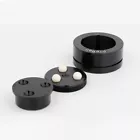Get a MiniDSP SHD and you can make your speakers do anything you want.
Speaker Isolation tweaks ?
Hi everyone,
I want to tweak my bookshelf speaker(Revival Atalante 3) isolation.So my speakers have small isolation feet attached to the speaker, which in turn just rests on top of my speaker stand. So technically not attached to the speaker stand. These are sand filled stands with adjustable spikes, resting on a hardwood floor. I currently use dimes underneath the spikes to prevent holes in my hardwood floors. So would something like the IsoAcoustics Gaia isolators work, by replacing my existing spikes with the Gaia isolators ? seems these are to be attached to floor standing speakers. If so, the Gaia iii is for speakers less then 40 lbs, but do you include the speaker stands ?
I kind of want to stay away from adhesives. Don't want to stain or mark up my speakers.
Anyway maybe people can share their thoughts on how they approach speaker isolation with bookshelf speakers on stands.
Cheers
@rick_n Or maybe IsoAcoustics Iso pucks ? |
I use Nobsound springs between my Spendor SP2/2 and the top of stands (cheap and effective - opens up soundstage and increases detail and dimensionality) or these get solid reviews: Seismic Isolation Pods (not so cheap!) |
Using the Gaia II’s on my KEF Reference One’s improved my soundstage. It is critical that the feet are on a smooth surface so they can grip it, or use their carpet spikes. It also requires that your speakers are very firmly attached to the stands so that the forces from the speakers can travel and be absorbed by the Gaia’s. Also note that the Gaia’s are directional and the logo on each foot has to face forward to get the full effect. And yes, you have to include the weight of the stands in your calculations. |
Ok sounds like the consensus is to just try them and try to hear a diff. My speaker stands weigh 70lbs, speakers weigh 25lbs. But the speaker stands only have 3 feet not the normal 4 feet, so weight calculation is different. I feel like that might put me into the Isoacoustics Gaia i category. Those are the most expensive of the lot. expensive trial and error. |
The Townshend podiums would be the best to isolate, they isolate down to three hertz and they stop the vibration from going into the floor and back up into the speaker again, you can put them right underneath your speaker stands you just have to get the right size and the right size cells for the weight of your speaker and stand, they are far superior to ISO acoustic Gaia according to everyone that's tried them both, they said that the ISO acoustic Gaia's were very good but The Townshend podiums were on a whole different level better, I bought them and put them underneath my monitor audio platinum 200 ll and the difference was as if I had upgraded to more expensive electronics, most significant upgrade that I've done to my system. |
Stack Audio. https://stackaudio.co.uk/ |
Lots of different input on this topic.... Making it even harder to decide. So I got a chance to buy Quadspire QX7 Isolators. Half the price I see them for online. Not sure if they will do much. These are just stainless steel feet that take in the plinth. Anyone know anything about these ? Am I still better of getting Gaia Isolators ? |
I've purchased some IsoAcoustics ISO-Puck minis. only cost $90. Bit of a cheap experiment. Still wondering if maybe I should get some stainless steel Floor Protectors and Enhancers. They hold the spikes and protect the hardwood floor. https://www.dedicatedaudio.com/products/quadraspire-qx7-floor-protectors-and-enhancers |
The want to spend money on an unknown product and one not commented on as a solution does present as being quite dismissive of the assistance on offer. Gaia Footers do work and so does the Townsend Podiums. I can vouch on these as my Loaned out AT 616 Feet used as Footers on Speakers assisted others in their making a decision about Isolating a Speaker. I would say between the three footers referred to above, there will be very little differences detected in their effect on the end sound of a Speaker. Cost of the Footers will be the deciding factor if all three were assessed side by side. There are very cost effective ways to experience a Pneumatic Footer, which will offer almost the same / the same effect as the above. Make a Design for a Sub-Plinth using a Sand Box with a extended Skirt to conceal the items in the Link, which should be produced to a very pleasing aesthetic finish if done DIY for no more than $100 and this will compete with any $1000 suspension device on offer as a Sub-Plinth. |
@lanx0003 there is a saying: don't buy a Ford at the Ford dealership, buy it at Kia The latter will want to get rid of it fast and cheap. Audio equipment is like a wedding cake, it's the same cake but 10 times more expensive than a "cake". A piece of rubber for a furniture foot is $2, for a turntable it's $20. I think vibration control is the most insane part of audiophilia.... |
Once again I bought the ISO pucks. I didn't want any adhesive sticking to my speakers. These pucks have suction. So I'm going to put them underneath the speakers and stick with spikes and get feet for the spikes. I guess that is another discussion..... Spikes with feet on hardwood floors GOOD or BAD ? Maybe just a screw with a flat end instead of spiked end ? |


 under my LaScalas. The good thing is that their adjustable for uneven floors, plus they tighten up the base.
under my LaScalas. The good thing is that their adjustable for uneven floors, plus they tighten up the base.